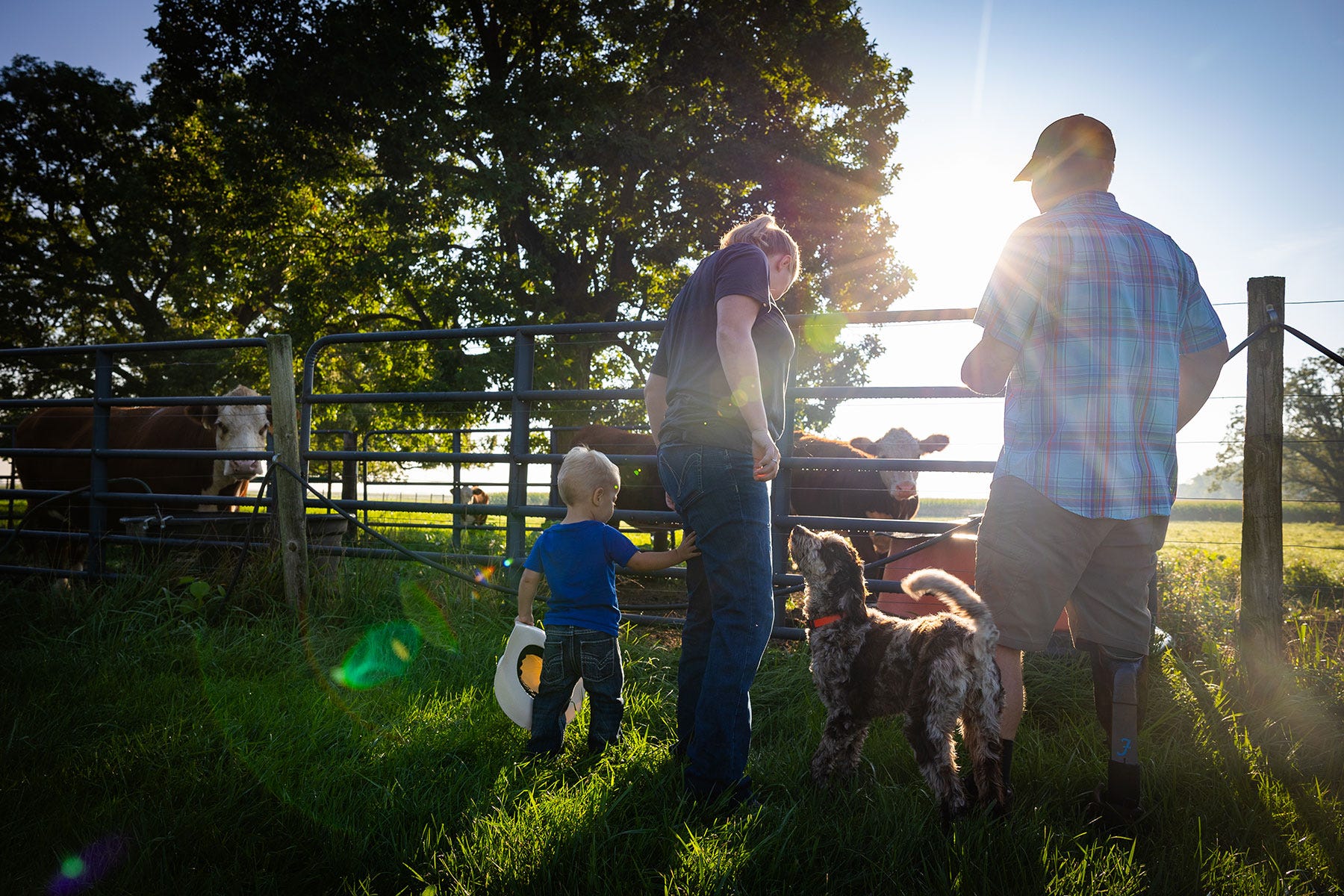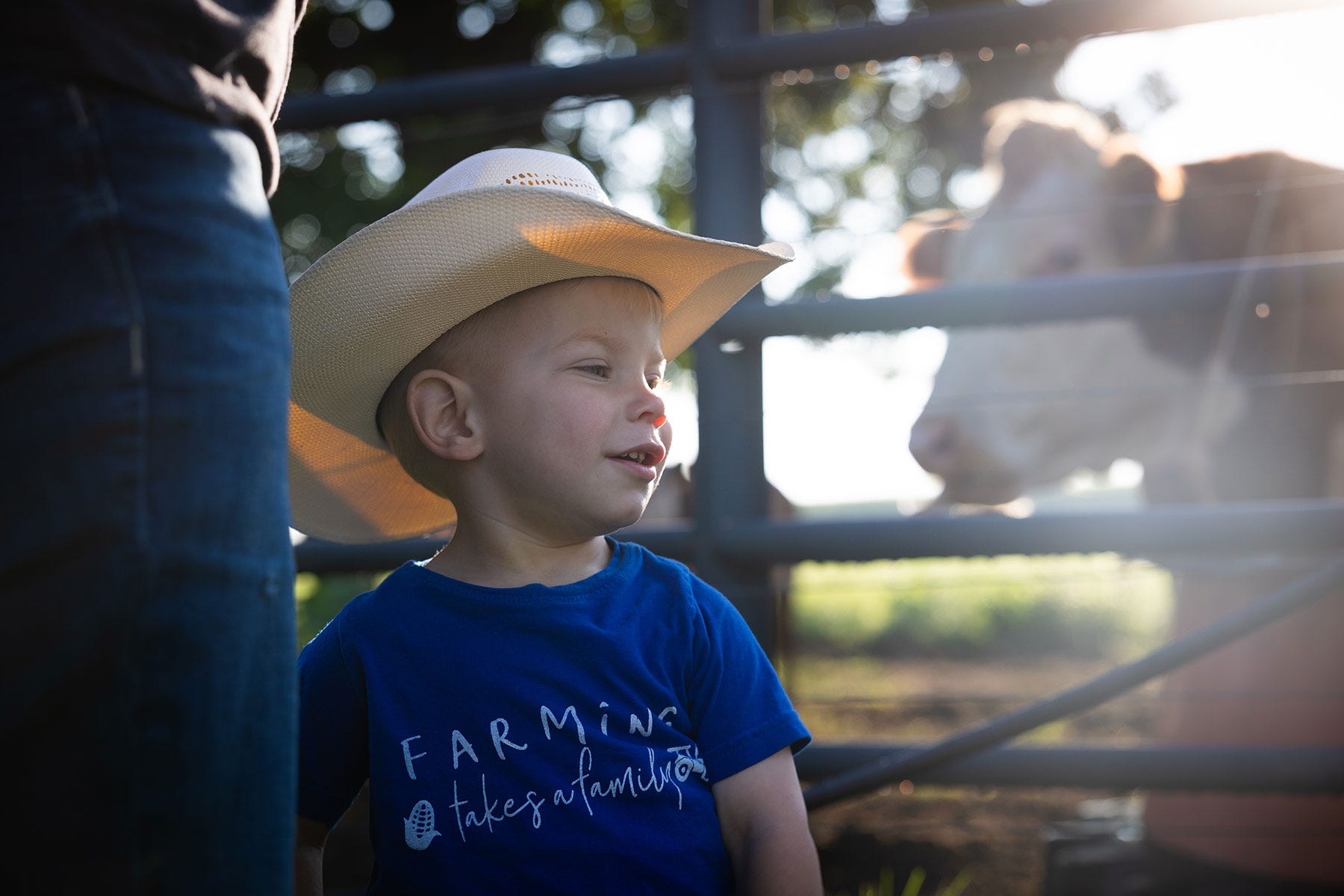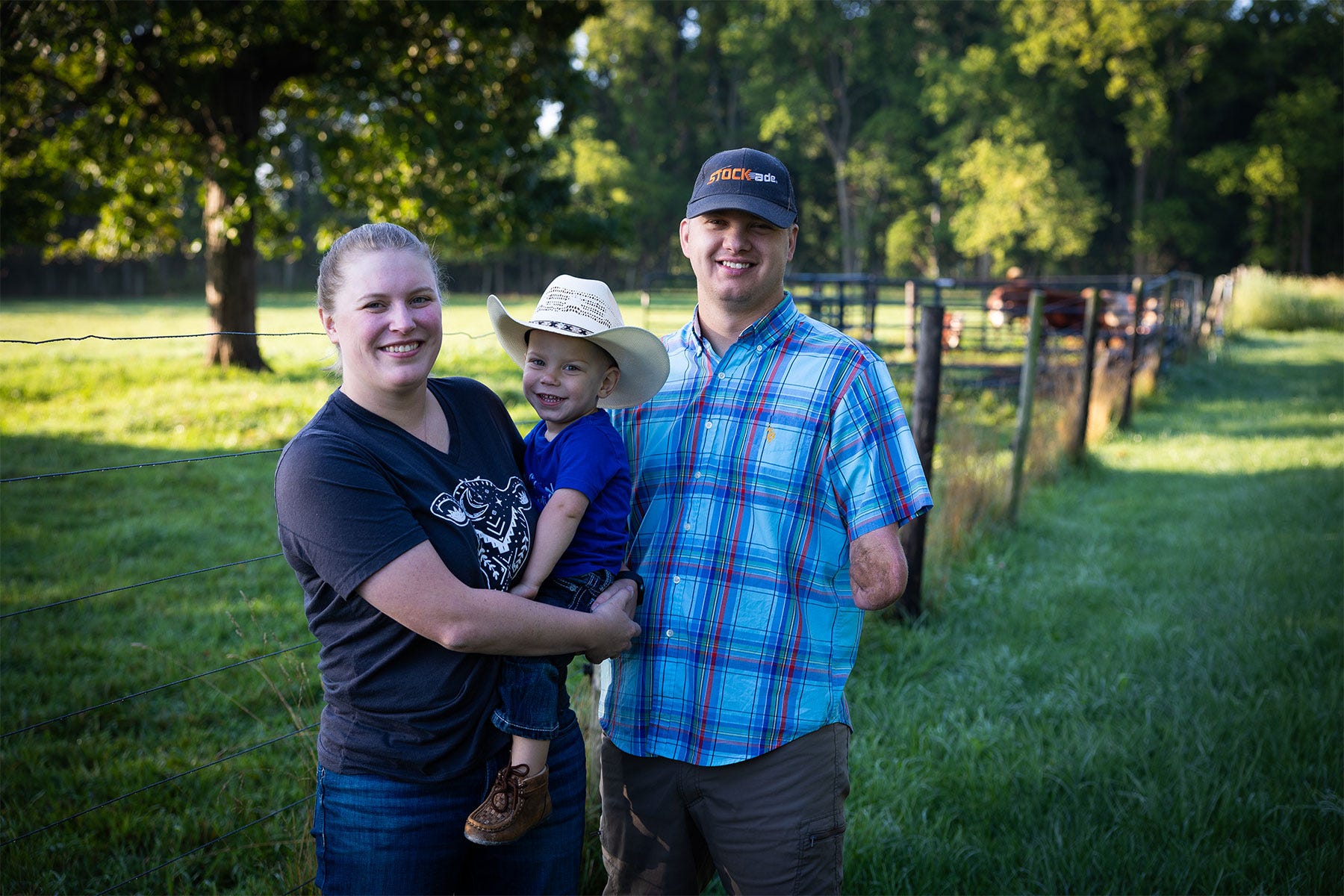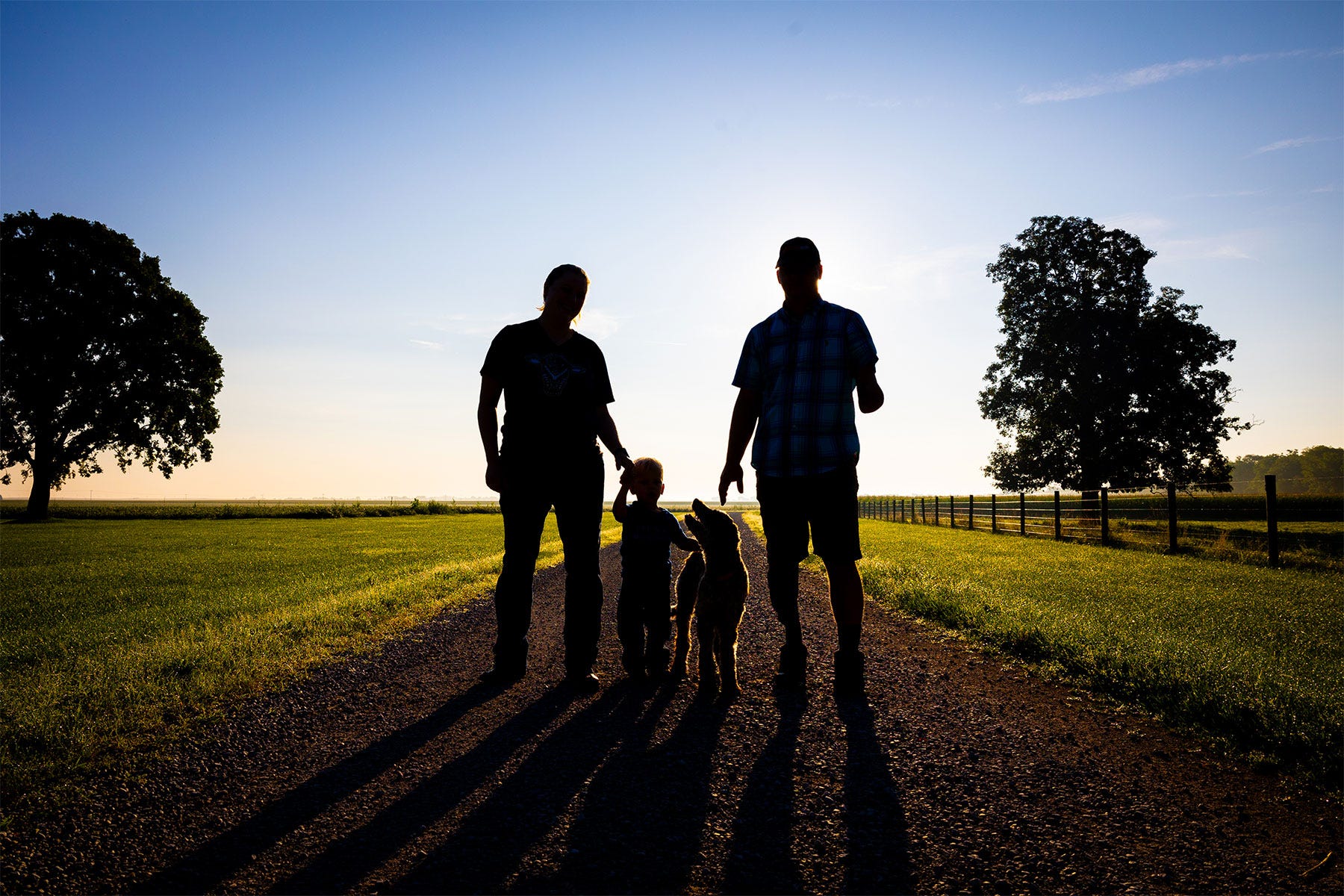August 22, 2023

On May 15, 2019, at 12:50 p.m., Bailey Conrady’s phone rang. It was her fiancé’s mom. She said Cody, her fiancé, had been in a farm accident. He was hurt badly. But what happened? Unsure. The extent of his injuries? Unclear.
“I was eating lunch with a co-worker when I got the call,�” Bailey recalls. “She could tell by the look on my face that something terrible had happened.”
Moments later, her phone rang again. It was the emergency room at OSF HealthCare in Peoria, Ill. They were transferring Cody to the burn unit at Springfield Memorial Hospital in Springfield, Ill. That meant his condition required a higher level of care.
“That’s when I knew it was bad,” she says. “But at least he was alive.”
Bailey made an agonizing hour-and-a-half drive from Champaign County to Springfield, calling family and friends as she drove to tell them what little she knew.
“It was the longest, shortest drive to Springfield I’ve ever made,” Bailey says. “I made it to Springfield in an amount of time that I probably shouldn’t admit to.”
Bailey and Cody were just 28 and 24, and they were getting married in four months. But now? Bailey’s mind raced to the worst as her emotions ran the gamut of disbelief, sorrow, fear, anger.
“I don’t know that I’ve yelled at God as much as I did during that drive,” she explains.
When Bailey arrived at the hospital, Cody was in surgery. It would be his first of seven.
“I remember seeing him in the hospital bed and thinking how small he looked,” Bailey says. “I think that sight will be seared into my brain for the rest of my life.”
The accident
May 15, 2019, started as a beautiful spring day — sunny, not a cloud in the sky. It was Cody’s second-to-last day working for a local ag retailer, and he was busy training his new replacement. His usual job was to help load trucks at the plant.
“We were short-staffed that day, so I ended up jumping in the truck just to keep ahead of the sprayers,” Cody says. “We had been running 12-hour days, six days a week, for two and a half months at that point.”
At the field, the sprayer operator unfolded the booms and extended the sprayer tips. One of the tips grazed a power line. No one had any idea.
“As I touched the sprayer, I took in 7,200 volts through my left hand and then out through my feet to ground,” Cody explains. The sprayer tip may have only been electrified for a moment, but it was the wrong moment for Cody.
In a split second, he was on the ground, unconscious. His co-worker started CPR and called 911. Minutes later, he was in a life-flight helicopter.
The days and weeks that followed were a blur of trauma, tears and heart-wrenching decisions.
“I don’t remember anything from an hour and a half before to a week and a half later,” Cody says.

MOVING FORWARD: Today, the Conradys have moved forward and don’t necessarily consider their story tragic. “We have a beautiful farm, a beautiful little boy, and a wonderful family. We’re farming and showing cattle and living the life we’ve always wanted,” Bailey says.
What they’d learn was that electrical burns damage your body from the inside out, and that tissue can continue dying for days — sometimes weeks. In Cody’s case, it took two weeks for tissue to stop dying, and for all the damage to reach the skin’s surface.
Doctors recommended amputating Cody’s left forearm and right leg below the knee. But Bailey had to make the call, which is every bit as traumatic as you’d imagine.
“There were times talking with Bailey where I was just trying to figure out what happened,” Cody says. “Why did they take my leg? I thought it would just be my thumb and index finger they’d have to take. But tissue was actively still dying over the course of two weeks, so they kept moving up.”
Cody spent the next 45 days in the burn unit, followed by months of physical therapy. Bailey hardly left his side.
“What they were able to do and give Cody in terms of quality of life has been amazing,” Bailey says. “We knew life wasn’t going to be the same. The normal before was not going to be the normal now.”
As their wedding date inched closer, Cody decided he was going to walk. But that would mean getting fitted with a prosthetic leg and then learning to walk on it. For most people, that takes months of physical therapy, and some are never able to walk successfully.
But Cody did it. Just four months after the accident and 10 days after getting his prosthetic, he stood at the altar with Bailey and walked down the aisle with her. It’s a feat he attributes to age, persistence and a little stubbornness.
Farm safety
On that sunny day in May, Cody narrowly escaped death. Hundreds, if not thousands, of farmers have been killed by electrocution, doing just what Cody was doing.
“The ag environment is incredibly hazardous,” says Josie Rudolphi, ag safety and health professor at the University of Illinois. “The fatal injury rate in agriculture is seven times higher than the all-worker, all-industry rate.”
Growing up on an Iowa farm, Rudolphi is passionate about advocating for what she calls “her people” and making everyone a little safer.
“When we talk about agricultural sustainability, the person is the most important part of the equation,” she says. “We have to have healthy and safe people in this workforce if we’re going to have a healthy, safe and adequate food supply.”

FAMILY FARM: The Conradys knew life had changed in the split second of the accident. “It’s not going to ruin your harvest if you take that extra minute to be safe. But it could be the end of your world if you don’t,” Bailey says.
Preventing ag injuries is exceptionally challenging because there are risks all over the farm — think tractor rollovers and runovers, livestock injuries, contact with PTO shafts or augers, falls from extreme heights, and grain bin accidents. Not to mention electricity.
The farm also poses unique dangers:
Most farms are exempt from Occupational Safety and Health Administration oversight.
Farmers often work alone.
There’s no mandatory retirement age.
Proximity to health care is often limited.
Hazards are both specific and varying. “There’s not just one strategy or intervention that’s going to mitigate every hazard,” Rudolphi says.
For electrical accidents, take note of overhead power lines and avoid them when emptying combines or moving equipment.
“Electricity is challenging,” Rudolphi says. “You can’t hear it, you can’t see it and you can’t smell it, but it’s all around us and very powerful.”
If a piece of machinery does get tangled up in a power line, it’s best to stay in the cab, call 911 and wait for emergency responders to help safely evacuate the vehicle.
“Your first reaction is to get out as fast as you can,” Rudolphi notes. “But as long as you’re on rubber tires and not completing a ground, you should be relatively safe.”
The only case when Rudolphi recommends leaving an electrically charged piece of equipment is if it’s on fire. In that case, exit quickly by taking a giant leap from the last rung of the ladder, landing with both feet together and hopping away like a bunny.
“It sounds ridiculous, but it helps prevent a circuit within the person,” she says. “If you get off of the ladder with one foot on the ground, you’re likely to be electrocuted.”

PERSEVERANCE: Today, life for the Conrady family looks a little different. They married in September 2019 and welcomed their first child, J.W., in January 2021.
For any farm injury prevention, Rudolphi says to slow down and assess the work environment. To prevent injuries, get reacquainted with seasonal equipment and take note of nearby roads, power lines, water sources, ditches or steep inclines.
As harvest approaches, Rudolphi recommends the following:
Make a plan to check on all farm workers multiple times during the day, especially in isolated areas.
Keep cellphones fully charged.
Keep first-aid kits and fire extinguishers in equipment.
Keep phone numbers for all farm workers and emergency personnel.
Keep accurate addresses for all farms and fields.
“If I call 911 and I say we have a combine fire at the Roberts 80, they won’t know where that is,” Rudolphi says. “Take some time now to find physical and emergency services addresses, print them out, and put them in every tractor, combine, semi and Gator that will be used during harvest.”
Perhaps most importantly, ensure that all parties are well-rested and take breaks as needed.
“During harvest, you’re beyond exhausted and just want to finish a field — I certainly get it,” Rudolphi adds. “But fatigue and exhaustion are typically when we see mistakes and injuries.”

FARM BOY: The Conrady family says their 2-year-old son, J.W., is a typical rambunctious farm boy. “If there’s a tractor moving, he wants to be on it. If we’re feeding cows, he wants to pour the buckets,” Bailey says.
4 years later
The Conradys agree. In the 10 weeks leading up to Cody’s accident, he had been running 12-hour days, six days a week. Everyone was tired.
“It was the middle of the season and we had gotten complacent,” Cody explains. He now speaks to groups around the country about electrical safety on the farm. “Take that extra second to look around you and see what dangers are there.”
Today, life for the Conrady family looks a little different. They married in September 2019 and welcomed their first child, J.W., in January 2021.
“I don’t necessarily consider our story tragic, especially now as we’ve moved forward,” Bailey says. “We have a beautiful farm, a beautiful little boy, and a wonderful family. We’re farming and showing cattle and living the life we’ve always wanted.”
Cody is farming full time, raising grain, hay and cattle; and Bailey is now the Champaign County Farm Bureau manager.
“The two questions I ask myself daily are, ‘Why did it happen?’ and ‘How am I still alive?’” Cody says.
But life today hasn’t come without its share of challenges. In the months that followed, Bailey experienced severe anxiety and panic attacks. She started therapy in 2020.
“It’s not bad to ask for help,” Bailey says. “It took a long time to realize I wasn’t going to solve this on my own. You never really get over it; you just learn to manage it better.”
Finding a supportive therapist, Bailey says, has changed her life as she continues to work through the trauma of 2019.
“The accident didn’t shake my faith, it just made it more complicated,” she says. “It’s rationalizing the fact that it happened. Why me? Why us? Why now?”
As for Cody, farming full time by himself is no easy feat, even though his friends and neighbors would say farming without all the limbs he used to have sure hasn’t slowed him down much.
“I’ve learned to do things smarter, not harder,” Cody says. “I do a lot of things different than I used to and have made some tools to help me around the farm.”
Think of all the small tasks that take two hands — like wrapping a tow strap. Cody built a special tool that lets him do that with one hand.

FARM ACCIDENT: Four years later, signs of the accident exist both physically and emotionally for the Conrady family. Cody lives and farms with a prosthetic leg and one arm, and Bailey started therapy in 2020 after experiencing severe anxiety and panic attacks.
The Conradys have shared their story with organizations across the country, connecting with other farmers injured in electrical accidents — most resulting from combines, augers or sprayers touching power lines.
Now, Cody says he’s hyperaware of electrical dangers around the farm. When he notices a sprayer under a power line in the spring or a semi beneath a power line in the fall, he cringes.
“We all get in a hurry during harvest,” Bailey says. “When the weather’s good and the crop’s ready, we have to get to the field. But we just want people to be safe.”
As fields turn from green to brown and harvest is imminent, it’s more important than ever to check for harvest safety hazards, stay alert when days get long and pay careful attention to surroundings.
“It’s not going to ruin your harvest if you take that extra minute to be safe,” Bailey says. “But it could be the end of your world if you don’t.”
About the Author(s)
You May Also Like






